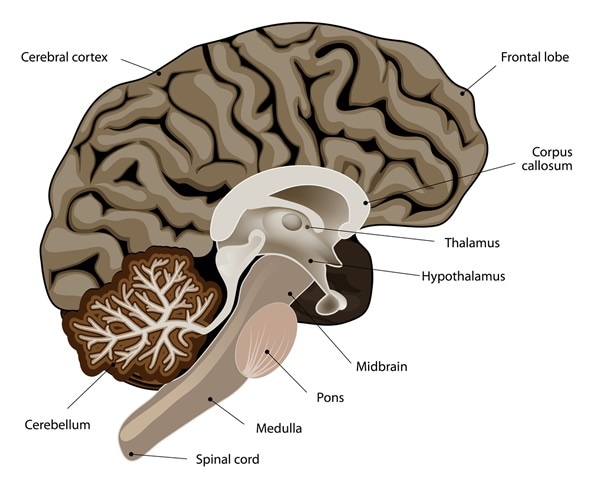The dorsal thalamus, usually simply referred to as the thalamus is a subdivision of a brain area called the diencephalon, which also includes the eptithalamus, the ventral thalamus and the subthalamic thalamus.

Vertical section of a human brain. showing the medulla, pons, cerebellum, hypothalamus, thalamus, midbrain. Image Copyright: Designua / Shutterstock
The thalamus relays sensory impulses from receptors in various parts of the body to the cerebral cortex. A sensory impulse travels from the body surface towards the thalamus, which receives it as a sensation. This sensation is then passed onto the cerebral cortex for interpretation as touch, pain or temperature.
The prevailing opinion among experts is that the thalamus serves as a kind of “gate,” filtering which information from various channels is allowed to be relayed by it for processing. Detailed research has shown that specific thalamic neurons can modulate informational transfer by employing specific discharge modes.
Furthermore, the thalamus is crucial for perception, with 98% of all sensory input being relayed by it. The only sensory information that is not relayed by the thalamus into the cerebral cortex is information related to smell (olfaction).
2-Minute Neuroscience: The Thalamus
Thalamic nuclei
The thalamus is made up of three distinct groups of cells or nuclei and these include the following:
- Sensory relay nuclei - These include the ventral posterior nucleus and the lateral and medial geniculate body. These nuclei relay primary sensations, by passing specific sensory information to the corresponding cortical area. For example, the lateral geniculate body receives information from the optic tract, and then outputs that information to the primary visual cortex.
- Association nuclei - These receive input from specific areas of the cerebral cortex, which is then projected back to the cerebral cortex to somewhat generalized association areas, where they regulate activity.
- Non-specific nuclei - These include the intralaminar and midline thalamic nuclei, which both receive input from the cerebral cortex and project information diffusely through it. Most of these nuclei interconnect brain activity between different areas of the brain and play a role in general functions such as alerting.
Aside from olfaction, in all sensory processing, a sensory signal is received by a thalamic nucleus and then directed to the relevant cortical area.
The involvement of thalamic nuclei in sensory systems
In the visual system, the thalamus receives input from the retina, which is relayed to the brain via the optic nerve. Signals are sent to the lateral geniculate nucleus of the thalamus which then forwards them onto the primary visual cortex (area V1) in the occipital lobe. The thalamus not only relays the information but also processes it, as each of the primary sensory relay areas receives information back from the cerebral cortex (called back projections).
On the other hand, the medial geniculate nuclei relay auditory information between the inferior colliculus of the midbrain and the primary auditory cortex. The thalamus is also important for touch - the ventral posterior nuclei relay information regarding touch and perception of bodily position to the primary somatosensory cortex in the cerebral cortex.
In addition, the thalamic nuclei are strongly and reciprocally linked with the cerebral cortex. These form the thalamo-cortico-thalamic circuits which are thought to regulate consciousness and the thalamus plays a significant role in arousal, wakefulness and alertness. Damage to the thalamus is associated with a significant risk of coma.
Further Reading
Last Updated: Jun 12, 2023